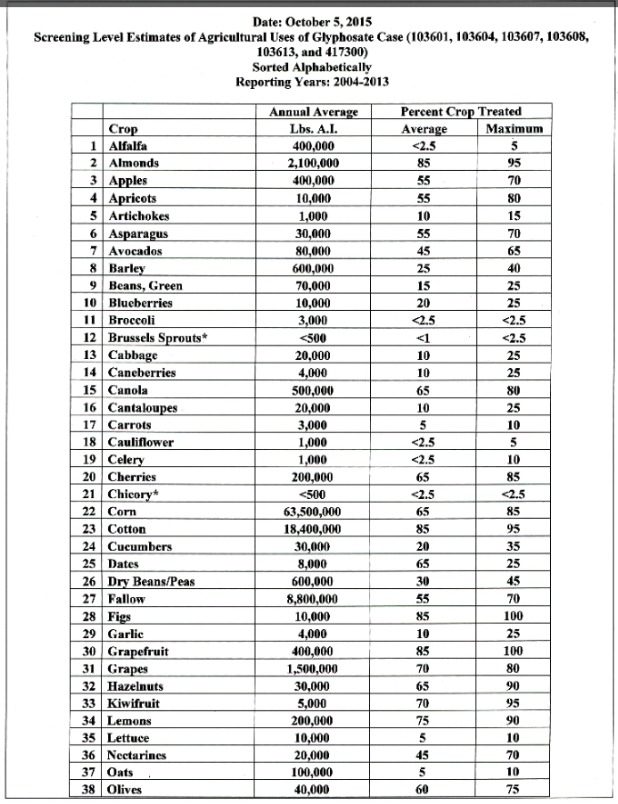Applying herbicides like Roundup 7-10 days before harvest is viewed as especially helpful for wheat that ripens unevenly, a common occurrence. It is also considered a helpful tool to initiate an earlier harvest when weather conditions threaten plant viability. Other benefits are earlier ripening for earlier replanting and reducing the green material in the field. This puts less strain on farm machinery during harvest.
Farmers euphemistically call the practice "desiccation". When used during wheat harvest, it can result in slightly greater yield by triggering plants to release more seeds.
The result? Most non-organic wheat in North America is now contaminated with glyphosate, the active ingredient in Roundup and similar herbicides.
WHO: Glyphosate a Probable Carcinogen
A March 2015 report by the World Health Organization identified glyphosate as a probable human carcinogen. Several EU countries have banned it as a result with more in the works.
However, in North America, glyphosate use shockingly continues to remain a popular farming tool.
And, as it turns out, use of Roundup as a drying agent on wheat prior to harvest is just the tip of the iceberg.
Dozens of other food crops are subjected to glyphosate dousing prior to harvest as well.
But Wait! Isn't Roundup Just for GMO Crops?
It is well known that Roundup is sprayed directly on GMO crops like corn and soy because they are genetically engineered to withstand the toxic onslaught without withering. So much Roundup is used on GMO crops, in fact, that herbicide-resistant "superweeds" are now a huge problem little more than a decade later (1).
"If Roundup kills plants that aren't genetically modified to resist it, then why use it on nonGMO crops?"
"Wouldn't glyphosate kill a nonGMO crop?"
"Why would a farmer do this?"
Indeed, these common consumer questions indicate the ultimate irony of using Roundup for desiccation purposes on a food crop producing farm. Killing the crop and/or the greenery around it is actually the whole idea. For crops like wheat, it evens up the field, allows for an earlier harvest, protects machinery and/or increases profit.
The bottom line?
Pre-harvest treatment of crops with glyphosate helps farmers to harvest their crops more efficiently and at less cost (2)
Crazy as it may seem, Roundup is used everywhere in the North American conventional food supply and not just on GMO crops or to kill weeds!
Glyphosate is applied directly to dozens of nonGMO food crops, in many cases, right before they are harvested. This is the worst possible time to apply a herbicide because it causes the glyphosate to be absorbed into the food crop directly. In other words, the glyphosate can't be washed off later as it has become part of the food. This toxin will then be ingested by those who consume it either directly as a "whole food" or via processed foods that contain it as an ingredient.
According to the Cornucopia Institute:
Ubiquitous in food production, glyphosate is used not just with row crops like corn, soybeans and wheat but also a range of fruits, nuts and veggies. Even spinach growers use glyphosate (3).Desiccating crops with herbicides before harvest is catching on in the UK as well where summers are wet and crops may ripen slowly and unevenly. This can potentially lead to reduced yields and a lower quality crop. For example, 78% of the UK oilseed rape crop (similar to canola) is desiccated before harvest, but only 4% in Germany (4).
Common Crops Desiccated with Glyphosate
The list of common crops desiccated with glyposate prior to harvest is shockingly long!
Seventy crops are on the current EPA list which runs from 2004-2013. The complete list of crops is shown in the images below taken from an EPA memo from October 2015. What's more, when the list is compared with a prior data snapshot through 2011, it shows that glyphosate use by farmers for key food crops alarmingly continues to grow.
Glyphosate use by farmers averages 70% or more for some crops. These include almonds, walnuts, figs, plums, prunes, grapes, kiwi, lemons, grapefruit, pistachios, and pomegranates.
What Glyphosate Does to the Human Body
The currently accepted view is that ghyphosate is not harmful to humans or any mammals. This flawed view is so pervasive in the conventional farming community that Roundup salesmen have been known to foolishly drink it during presentations!
Just because Roundup doesn't kill you immediately doesn't make it safe though! The health-robbing effects are actually slow and insidious over months and years.
The decline in health occurs because glyphosate lethally disrupts the shikimate pathway found in beneficial gut microbes. This probiotic pathway is responsible for synthesis of critical amino acids and the cytochrome P450 (CYP) enzymes. CYP enzymes are used by the body to detoxify the multitude of foreign chemical compounds and xenobiotics. No matter where we live, we are exposed to these toxins in our modern environment every single day.
As a result, people exposed to glyphosate residue through ingestion of food crops treated with it just before harvest become even more vulnerable to the damaging effects of other chemicals and environmental toxins they encounter! This is possibly the worse result of glyphosate exposure. It makes you a sitting duck for any other toxins you encounter.
In addition, by significantly disrupting the functioning of beneficial bacteria in the gut, permeability issues related to the intestinal wall can occur over time. This slow degradation of gut function encourages the development of a myriad of autoimmune disease symptoms. These diseases include celiac disease, food allergies, Crohn's, IBS, asthma, ulcerative colitis, MS, lupus, eczema, cancer and the list goes on and on.
The Glyphosate Million Dollar Question
Hence the chicken and egg question:
Is gluten in the wheat really the problem or is it actually the glyphosate residue sprayed on the wheat?The same can be said for other foods. Is it really the food(s) that are triggering an autoimmunity problem or the glyphosate that is being sprayed on it?
How Much Roundup Residue are We Eating?
Consumers are increasingly alarmed by the monstrous rise in the use of glyphosate containing herbicides on food crops. In the United States, they are calling for testing of residues to determine if the levels are safe. Such testing is done for other agrichemicals, why not Roundup?
Unfortunately, until regular testing is done, we really have no idea how much glyphosate all of us are really eating. One thing is for sure: the more GMO and nonorganic food a person eats, the more glyphosate exposure is wreaking havoc with his/her gut environment.
The good news is that early in 2016, the FDA said that it will start testing for glyphosate residues although on a limited basis (5).
In the meantime, it really is best to insist on organically produced food as much as possible. The list of crops desiccated with glyphosate is far too long and the risk to health far too high to consider otherwise.
Sarah, The Healthy Home Economist
Sarah Pope MGA
Sarah Pope has been a Health and Nutrition Educator since 2002. She has served on the Board of Directors for the Nutrition nonprofit the Weston A. Price Foundation since 2011.
Sarah earned a Bachelor of Arts (summa cum laude, Phi Beta Kappa) in Economics from Furman University and a Master's degree in Government (Financial Management) from the University of Pennsylvania.
Mother to three healthy children, blogger, and best-selling author, she writes about the practical application of Traditional Diet and evidence-based wellness within the modern household. Her work has been featured by USA Today, The New York Times, National Review, ABC, NBC, and many others.






Comment: See also: